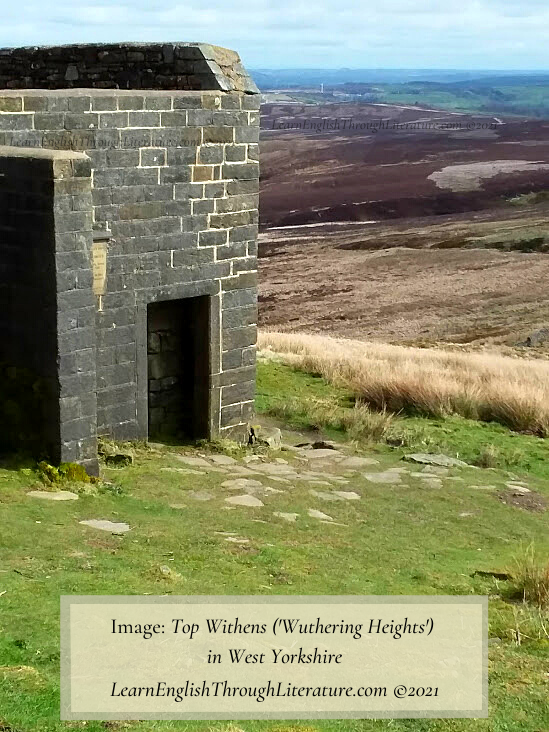📙 ‘“… Nelly, I am Heathcliff! He’s always, always in my mind: not as a pleasure, any more than I am always a pleasure to myself, but as my own being. So don’t talk of our separation again …”’
– Cathy Earnshaw in Emily Brontë’s Wuthering Heights (1847)
In this second Part of our Lesson on ‘being’, the present participle form of the verb ‘to be’, we will cover four other aspects or uses that this word has in English.
…
#5 📝 DESCRIBES GENERALISATIONS
✍️ When using ‘being’ to make generalisations, you must follow it with a past participle, such as ‘lost’ in this sentence:
📙 ‘Do you know that you run a risk of being lost in the marshes?’
– Emily Brontë, Wuthering Heights (emphasis mine)
…
#6 📝 PARTICIPLE CLAUSES
‘Being’ is also used is in participle clauses.
I will illustrate this by showing you a few sample sentences first. Here is a sentence I wrote, a paraphrase of Emily Bronte’s own words:
✒️ I was unable to remove the chain, so I jumped over the wall … [my sentence]
Now see how Emily Bronte uses ‘being’ in a participle clause here:
📙 ‘Being unable to remove the chain, I jumped over, and, running up the flagged causeway bordered with straggling gooseberry-bushes, knocked vainly for admittance, till my knuckles tingled and the dogs howled.’
– Emily Brontë, Wuthering Heights (emphasis mine)
✍️ Participle clauses give further information about a sentence’s subject.
They allow a sentence to be fairly flexible, with different clauses that can be moved around in a sentence without changing its meaning (only its emphasis). For example, Emily Bronte could have written her sentence like this and it would have meant the same:
✒️ I jumped over [the wall], being unable to remove the chain, and, running up the flagged causeway … [my sentence]
However, I think Emily Bronte most likely placed her ‘being’ participle clause at the start of her sentence because clauses in that position tend to be the most emphasised of all.
Notice how ‘I’ is emphasised instead in this next sentence by its being placed right at the beginning of the sentence:
📙 ‘I, being your legal protector, must retain you in my custody, however distasteful the obligation may be.’
– Emily Brontë, Wuthering Heights (emphasis mine)
In this next sentence, ‘but’ (indicating a contrast with what had been mentioned before) is the word stressed here:
📙 ‘But, being in disgrace, I was not favoured with a description of the interesting objects she saw.’
– Emily Brontë, Wuthering Heights (emphasis mine)
…
#7 📝 USED AS A GERUND
It can also be used as a gerund (a verb form that acts like a noun). For example, one of my friends recently had a baby and told me that she ‘loved being a mother’. Here ‘being’ is an identifiable state, which makes it a noun, hence a gerund. (Check out my Lesson on gerunds for a fuller explanation of this.)
Notice the different gerunds in these quotations:
📙 ‘“I wish I had light hair and a fair skin, and was dressed and behaved as well, and had a chance of being as rich as he will be!”’
– Emily Brontë, Wuthering Heights (emphasis mine)
📙 ‘“Mrs. Heathcliff,” I said earnestly, “you must excuse me for troubling you. I presume, because, with that face, I’m sure you cannot help being good-hearted …”’
– Emily Brontë, Wuthering Heights (emphasis mine)
Here is a very common one in English – ‘being in love’:
📙 ‘“… He does not know what being in love is!”’
– Emily Brontë, Wuthering Heights (emphasis mine)
📙 ‘I experienced pleasure in being able to exasperate him: the sense of pleasure woke my instinct of self-preservation, so I fairly broke free; and if ever I come into his hands again he is welcome to a signal revenge.’
– Emily Brontë, Wuthering Heights (emphasis mine)
…
#8 📝 DESCRIBES A HUMAN (OR SPIRITUAL) ENTITY
📙 ‘“Don’t put faith in a single word he speaks. He’s a lying fiend! a monster, and not a human being!”’
– Emily Brontë, Wuthering Heights (emphasis mine)
Lastly, we have ‘being’ as a noun (related to ‘being’ as a gerund) that describes what we also call more fully a ‘human being’. Sometimes the adjective ‘human’ is excluded, so that ‘being’ means ‘an existing person or spiritual entity‘.
📙 ‘I was vain of his commendations, and softened towards the being by whose means I earned them …’
– Emily Brontë, Wuthering Heights (emphasis mine)
📙 ‘“Nelly, I am Heathcliff! He’s always, always in my mind: not as a pleasure, any more than I am always a pleasure to myself, but as my own being. So don’t talk of our separation again …”’
– Emily Brontë, Wuthering Heights (emphasis mine)
‘Being’ can therefore mean ‘an existing or living person’ or even ‘the existence of a person’.
This latter meaning is what we find here:
📙 ‘“Oh! my heart’s darling! hear me this time, Catherine, at last!” The spectre showed a spectre’s ordinary caprice: it gave no sign of being; but the snow and wind whirled wildly through, even reaching my station, and blowing out the light.’
– Emily Brontë, Wuthering Heights (emphasis mine)
She uses ‘being’ here (as ‘existence of a person’) to contrast with the non-personal ‘snow and wind’ and ‘light’. It is a strong contrast and full of drama! ✨
…
I trust this has been a helpful overview of ‘being’ in all its forms and purposes.
👉 P.S. You can join me later this week for another Lesson on this subject, in which we will focus solely on the past participle – ‘been’ – and how and when to use it correctly.




